Simplifies construction project management but lacks broader workforce tools such as scheduling, time tracking, and built-in chat.
Verdict: 7/10
LetsBuild tackles coordination challenges in construction projects. I think features like site diaries, task notifications, form compliance tracking, and real-time project updates will be useful for mid-sized to large firms. The platform centralizes project information, offering progress tracking, reporting tools, and structured workflows that help reduce administrative tasks and improve project oversight.
However, LetsBuild has a noticeable learning curve—it’s not the easiest platform to dive into. And while it shines in managing complex, large-scale projects with multiple stakeholders, it lacks built-in scheduling and time-tracking features, focusing instead on task progress tracking and real-time updates.
Key Features:
- Project management: Efficiently plan, execute, and monitor construction projects in real time.
- Document management: Centralize and version-control project documents like drawings, blueprints, and contracts.
- Drawing annotation: Collaborate in real time by marking up and tracking changes directly on plans.
- Quality assurance: Define and conduct standardized inspections and record observations digitally.
- Snagging module: Capture and track defects with photo documentation and instant notifications.
Pros
- Comprehensive construction project management
- Extensive snagging, quality, and safety controls
- Strong offline capabilities
- Real-time collaboration features
- Comprehensive version control
Cons
- Non-transparent pricing
- Steep learning curve
- Potentially overwhelming for small projects
- Lacks scheduling, time tracking, and chat
- Lacks tools for tracking workers’ locations
LetsBuild Pricing
LetsBuild is the result of a merger of 2 companies: Geniebelt and Aproplan. While the companies joined forces, their products—LB Geniebelt and LB Aproplan—remain separate but complementary.
- LB Aproplan: Available as a web and mobile app, it focuses on site management tasks like inspections, defect tracking, and quality control.
- LB Geniebelt: Accessible via web only, it specializes in project planning, scheduling, and task management.
Unlike other platforms that offer transparent pricing, LetsBuild keeps things under wraps. This kind of secrecy is normal in enterprise construction software, where costs often depend on the size of your project and your company’s needs.
| Plan | LB Aproplan | LB Geniebelt |
| What it’s for | Snagging, quality, and safety control (All project types) | Multi-project schedule communication (For volume builders) |
| Key Features | – Snagging with on-plan pins – QHSE checklists and forms – Documents and plans – Offline usage – Free access for subcontractors – Unlimited data storage – EU-hosted, GDPR compliant | – Interactive Live Gantt – Real-time progress updates – Excel/P6/MSP compatibility – 1-click task reports – Free access for subcontractors – Unlimited data storage – EU-hosted, GDPR compliant |
| Pricing | Custom pricing | Custom pricing |
I’ve heard mixed things about the pricing from different user reviews and third-party websites.
Some on TrustRadius say it’s $35-59/user/month for different modules, with extra features like Geniebelt adding more.
Capterra reports these prices:
- LB Aproplan – €104/user/month: Snagging, quality, and safety control for all project types, mobile and web app, free access for subcontractors, unlimited data storage, user and access management.
- LB Geniebelt – €104/user/month: Multi-project scheduling and communication for volume builders, mobile and web app, free access for subcontractors, unlimited data storage, user and access management.
These prices aren’t confirmed by LetsBuild. You must contact the vendor to get an accurate quote based on your needs.
When comparing this pricing to other construction management software, I found that LetsBuild seems to be priced at the high end if you need both apps. For example, Autodesk Build charges $199/user/month, and Fieldwire’s business plan is $59/user/month when billed annually. Connecteam, another construction workforce tool, starts at just $29/month for up to 30 users on the Basic plan or $99/month on the Expert plan—making it the most affordable of all.
| Team Size | LetsBuild (Aproplan + Geniebelt) | Autodesk Build | Fieldwire (Business) | Connecteam (Expert) |
|---|---|---|---|---|
| View pricing | View pricing (excluding tax) | View pricing | View pricing | |
| 10 Users | Custom pricing | $1190/month | $590/month | Free for life — All features and dashboards |
| 20 Users | Custom pricing | $2380/month | $1180/month | $99/month |
| 30 Users | Custom pricing | $3570/month | $1770/month | $99/month |
| 50 Users | Custom pricing | $5950/month | $2950/month | $159/month |
| Learn more about Connecteam. | ||||
| * All prices show the monthly cost when billed annually. As of March 2025. | ||||
Verdict: 4/10
LetsBuild Usability and Interface
LetsBuild offers two options for getting started: booking a free demo or testing the product directly. However, when I attempted to test the product, I was redirected to the demo request page, where I had to submit my details, including a business email.
Shortly after, a sales rep emailed, sharing a presentation deck outlining LetsBuild’s capabilities and promising a follow-up demo session. Unfortunately, I never heard back about the demo.
To provide a comprehensive review despite this, I explored LetsBuild’s help center resources, watched demo videos on YouTube, and analyzed user feedback across various review platforms to bring you a well-rounded, informed perspective.
Based on my explorations, LetsBuild’s interface strikes me as practical and straightforward. It is clearly designed with construction professionals in mind rather than chasing trendy design elements. The main dashboard presents project thumbnails with status bars and images that give quick visual cues about project progress.

Navigation seems intuitive through the dark blue bar at the top, with clear pathways to the Projects and Company sections. The project selection screen with searchable thumbnails makes it relatively easy to manage multiple projects within a single system.
However, there is a noticeable learning curve. New users might need dedicated training time to become comfortable with all the features and navigation paths.
One reviewer has even noted: “The learning curve for the platform can be steep, especially for team members who are not accustomed to working with construction project management software.”
LetsBuild offers limited accessibility options. The platform doesn’t appear to include features like screen reader compatibility, keyboard navigation shortcuts, or text size adjustments that would make it more accessible to users of different abilities.
Verdict: 7/10
Mobile app
LetsBuild offers the Aproplan mobile app for on-site work. The menu items include: Points, Forms, Documents, Participants, Options, and Synchronisation.
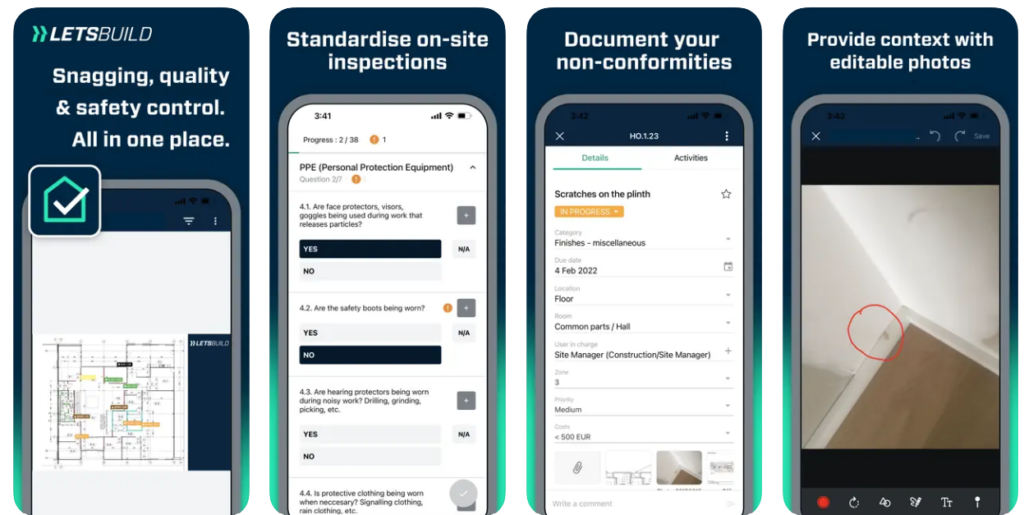
Based on what I could see, the mobile app seems useful for logging issues, uploading photos, marking up drawings, and completing checklists. Even on the small screen, you can switch to the editor mode to mark up drawings, pinch to zoom in and out, and even activate measurement features such as areas, distances, and perimeters.
Plus, it works offline, so you can update information without an internet connection and sync it later.
Unfortunately, the Aproplan mobile app can be slow, and the navigation isn’t very intuitive. While it’s easier to fill out the forms on the mobile app versus the web version, other features look cluttered on the mobile version.
Something important to note: Geniebelt is available only through a web browser on desktops and mobile devices—unlike Aproplan, it has no standalone mobile app. It’s optimized for mobile, so you can add it to your home screen. There, you can see your projects, tasks, and their statuses.
Across both apps, here’s how the mobile app functionality compares with the web versions:
| Menu item | Admin | Employee | ||
| Website | Mobile App | Website | Mobile App | |
| Core features | ||||
| Forms & Checklists (QA/QHSE) | ✅ | ✅ | ✅ | ✅ |
| Snagging & Defect Tracking | ✅ | ✅ | ✅ | ✅ |
| Digital Signatures | ✅ | ✅ | ✅ | ✅ |
| Document Uploads & Version Control | ✅ | ✅ | ✅ | ✅ |
| Drawing Markups & Annotations | ✅ | ✅ | ✅ | ✅ |
| Photo Documentation | ✅ | ✅ | ✅ | ✅ |
| Offline Access | ❌ | ✅ | ❌ | ✅ |
| Subcontractor Access | ✅ | ✅ | ✅ | ✅ |
| Task Assignment & Notifications | ✅ | ✅ | ✅ | ✅ |
| Analysis | ||||
| Project Dashboard (Visual Status) | ✅ | ❌ | ✅ | ❌ |
| Daily Site Diary | ✅ | ✅ | ✅ | ✅ |
| Activity Feed / Logs | ✅ | ❌ | ✅ | ❌ |
| Analytics Dashboard (KPIs, Stats) | ✅ | ❌ | ✅ | ❌ |
| Custom Reports & Templates | ✅ | ❌ | ✅ | ❌ |
| Management | ||||
| Role-Based Access Control | ✅ | ❌ | ❌ | ❌ |
| Project Scheduling (Gantt) | ✅ | ❌ | ✅ | ❌ |
| Task Progress Tracking | ✅ | ✅ | ✅ | ✅ |
| Multi-Project View | ✅ | ❌ | ✅ | ❌ |
| Document Permissions Management | ✅ | ❌ | ❌ | ❌ |
Verdict: 6/10
LetsBuild Core Functionalities
Let’s take an in-depth look at LetsBuild’s key features.
Forms for quality assurance
In LetsBuild, a form is a digital checklist used for quality control, QHSE inspections, and various audits in construction and facility management. It lets you collect and organize information in a structured way, whether online or offline.

LetsBuild offers 3 types of forms:
- Safety forms cover worker safety and site conditions, including safety briefings, inspections, and incident reports.
- Environment forms ensure projects meet environmental standards, including chemical storage, waste disposal, and site management standards.
- Quality forms help verify that work meets required standards, covering areas like facades, roofing, finishing, and formwork.
LetsBuild offers various pre-made checklists that align with industry standards, which I think will be a real time-saver for teams eager to adopt digital inspections quickly. You can also create custom forms/checklists that fit your specific needs.
When a team member identifies an issue, the system cleverly creates a task and assigns it directly to a team member, effectively reducing the usual communication delays in construction projects.
Digital signature capabilities are a great addition, allowing for an auditable trail of quality control actions. With mobile integration, your employees can complete forms directly on site, capturing photos and geographic data in real time, which I find incredibly useful.
Verdict: 9/10
Defect and snagging management
Managing construction snags (minor issues or unfinished work) or more serious defects is always challenging. LetsBuild’s defect management is designed to make this easier by using a digital system to spot and fix problems on site.
This module uses a system of Points and Tags to track issues. A Point is any annotation related to a construction project that can be attached to a plan and documented with photos. Points are essentially digital pins that mark the exact location of an issue on your project drawings or plans.
For example, when you spot a cracked tile in bathroom 302, you can place a Point directly on the digital floor plan of that bathroom, making it easy for everyone to see exactly where the problem is.
Tags complement Points by categorizing the type of issue. Each Point can be tagged with relevant categories like “Electrical,” “Plumbing,” or “Finishing,” making it easy to filter and sort issues. For instance, a project manager can quickly pull up all “Electrical” tagged Points to review with the electrical subcontractor.
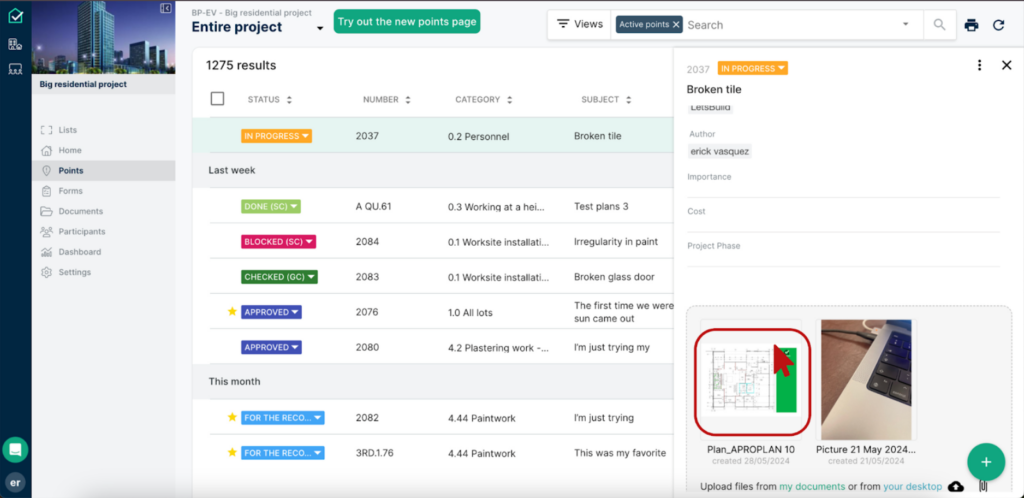
The module lets users quickly record defects with photos taken on their mobile devices. I especially appreciate how users can pin issues directly on digital floor plans.
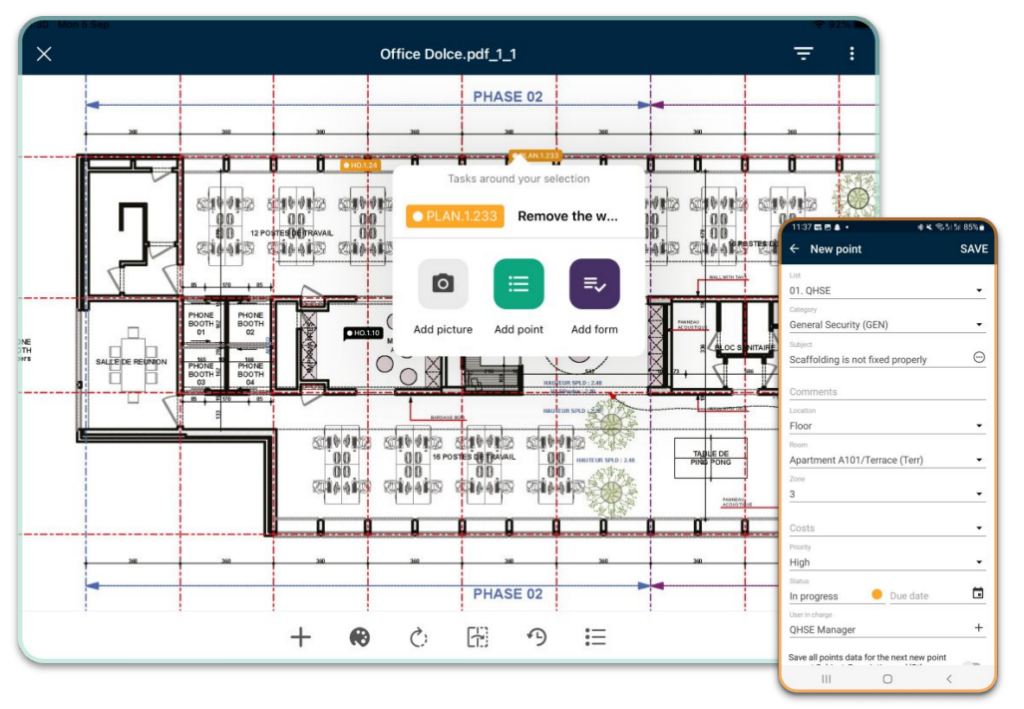
Subcontractors get instant alerts on their phones with all the details they need about what to fix, the timeline, and the expected duration of the work.
However, there are some downsides. The interface feels a bit clunky, and managing multiple defects can get confusing, especially on larger projects. While the Points and Tags system improves tracking, it doesn’t replace true GPS-based location tracking. The system logs the location of the defect, not the worker.
For many users focused specifically on snagging and quality control, this may be sufficient. However, it’s worth noting that this is currently the only form of location tagging LetsBuild provides—unlike some construction apps that offer GPS tracking for broader purposes like monitoring worker check-ins or movement across job sites.
Verdict: 9/10
Daily logs, photos, and document management
LetsBuild’s document management module centralizes all project task-related updates, photos, and files in one place.
I was impressed by the version control. Every document uploaded automatically gets timestamped and tracked, ensuring teams always have the latest version. You can easily compare different plan versions with just a click—which I find so helpful.
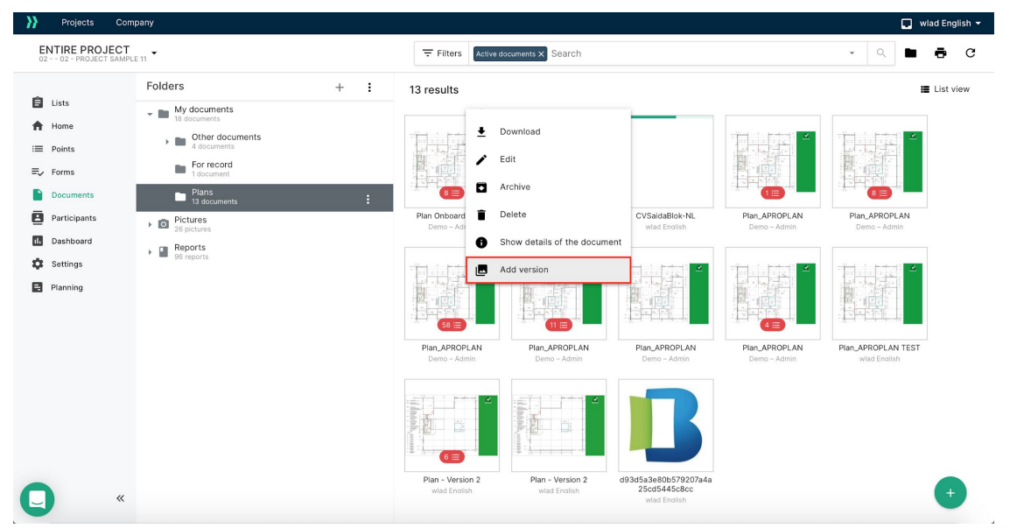
Uploading and tagging photos is straightforward, allowing site managers to link images to specific tasks or project phases quickly.
Additionally, the document-sharing features are secure, letting project managers control who sees what. I think the offline access feature sounds very useful, as it lets users view and update documents even in places with bad internet.
Also, the system handles various file types, including CAD drawings and PDFs.
Verdict: 8/10
Project management (Geniebelt)
LetsBuild’s project management capabilities, powered by Geniebelt, focus on task assignments and progress tracking. The Gantt chart serves as the backbone of the scheduling system, helping teams map dependencies, set milestones, and monitor deadlines.
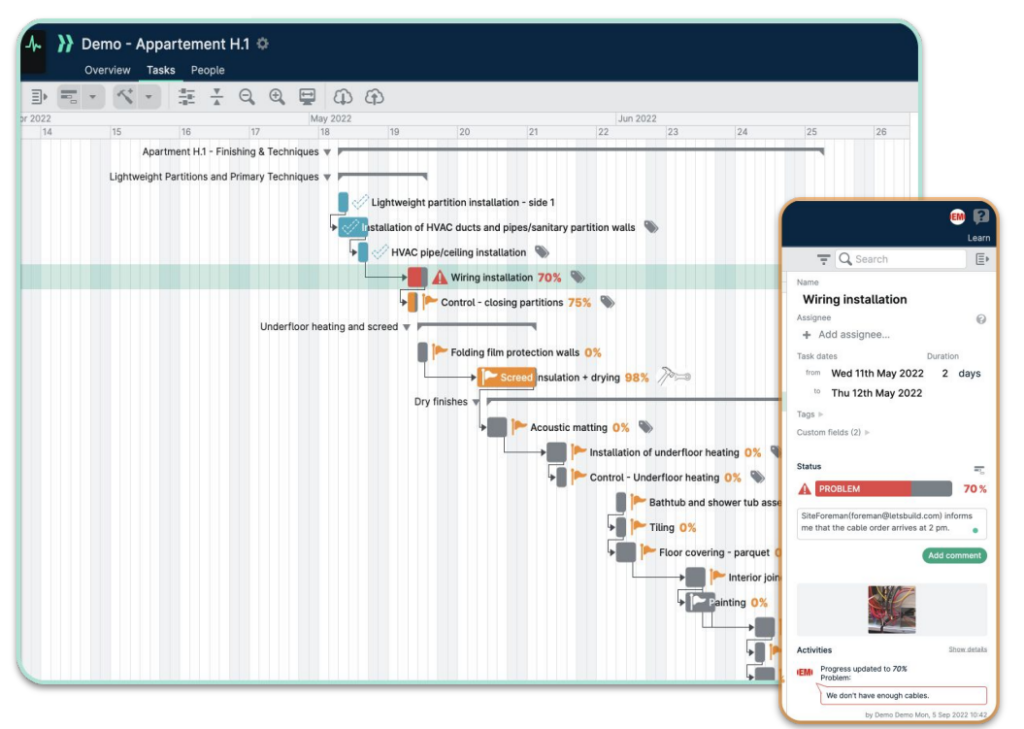
While it’s not as advanced as Microsoft Project or Primavera P6, it provides a clear, visual timeline that keeps projects moving forward.
LetsBuild’s scheduling capabilities revolve around project timelines and task coordination. The scheduling mode determines whether tasks with dependencies adjust automatically when changes occur.
LetsBuild gives you 2 ways to handle task scheduling:
- Automatic Scheduling: If one task gets delayed, the start dates for any linked tasks will automatically be adjusted.
- Manual Scheduling: If one task gets delayed, linked tasks won’t move—you must adjust them yourself.
This helps manage project timelines, but it doesn’t handle worker scheduling (which may also require adjustments if tasks are adjusted). If you need tools for scheduling shifts/jobs, time tracking, or workforce management, an app like Connecteam is a better option.
The LetsBuild dashboard presents real-time project tracking, allowing managers to see task updates instantly. I think the multi-project view is especially useful for overseeing multiple sites at once, though it seems to feel cluttered with too many projects.

Verdict: 8/10
Communication tools
LetsBuild offers structured communication focused on project coordination rather than 1:1 conversations. The notification system automatically alerts team members about updates, assignments, and deadlines based on their roles.
The platform connects communications directly to relevant project elements through comment features on tasks, documents, and issues. I think this can help keep conversations organized and create a permanent record of discussions tied to specific work items.
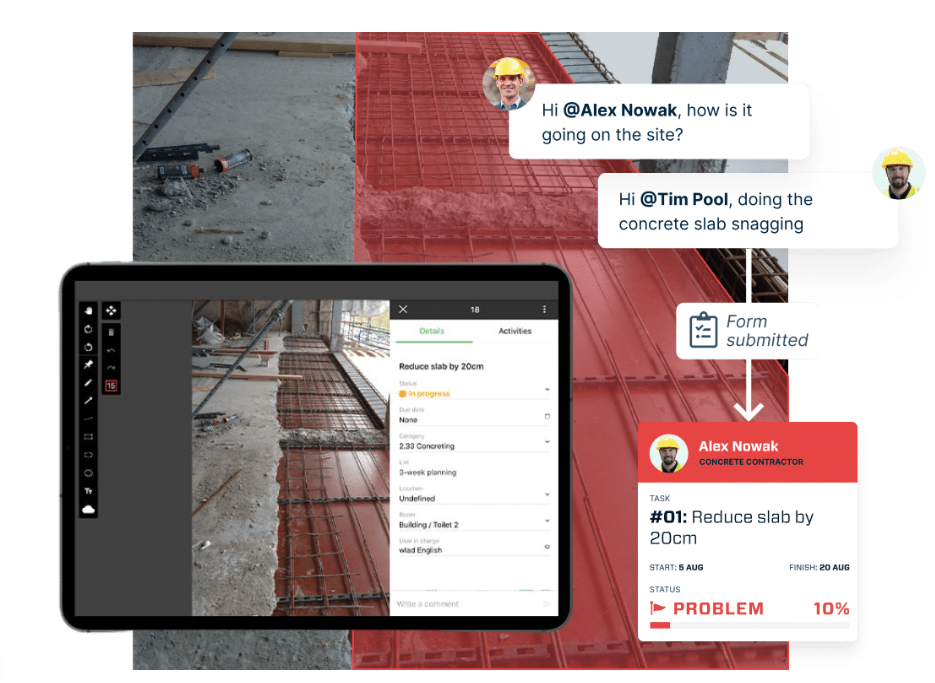
Users can access all their notifications in a central hub, making it easier to track and prioritize action items.
However, LetsBuild lacks integrated real-time chat functionality, which competitors like Connecteam offer. This means teams must use external tools for quick exchanges and informal discussions.
Verdict: 6/10
Integrations
LetsBuild offers limited but strategic integrations with key construction management tools. I think the connections with Microsoft Project, Primavera, and Excel are the most notable.
The platform supports basic import/export functionalities for project plans and scheduling data. API capabilities enable some custom integrations, but users might find themselves manually transferring information between systems even with these integrations.
Other construction management solutions I’ve reviewed offer more integrations—showcasing LetsBuild’s limited capabilities in this area.
Verdict: 5/10
LetsBuild Security
LetsBuild prioritizes data security to protect sensitive construction project information. The platform includes multiple layers of protection to ensure that only authorized users can access, edit, or share critical data:
- Role-based access control: Admins can define who can view, edit, or modify specific project data.
- Two-factor authentication (2FA): Adds an extra verification step for secure logins.
- Data encryption: Protects information both during transfer and while stored in the system.
- Audit trails: Tracks user actions, document changes, and project updates for full transparency.
While not military-grade, LetsBuild’s security framework provides strong protection for construction projects, ensuring data integrity, compliance, and secure collaboration.
Plus, it’s GDPR-compliant, meaning it adheres to the EU’s data protection regulations for handling personal data.
Verdict: 8/10
LetsBuild Reporting and Analytics
LetsBuild provides several specific report types tailored for construction management. Some examples include:
- Daily Site Diary Reports document daily activities, weather conditions, and workforce details.
- Snag List Reports highlight defects and their resolution progress.
- Inspection Checklists ensure compliance with quality and safety standards.
- Material Inventory Reports track materials used and remaining stock.
- Custom Reports are tailored to project-specific needs, combining various data points.
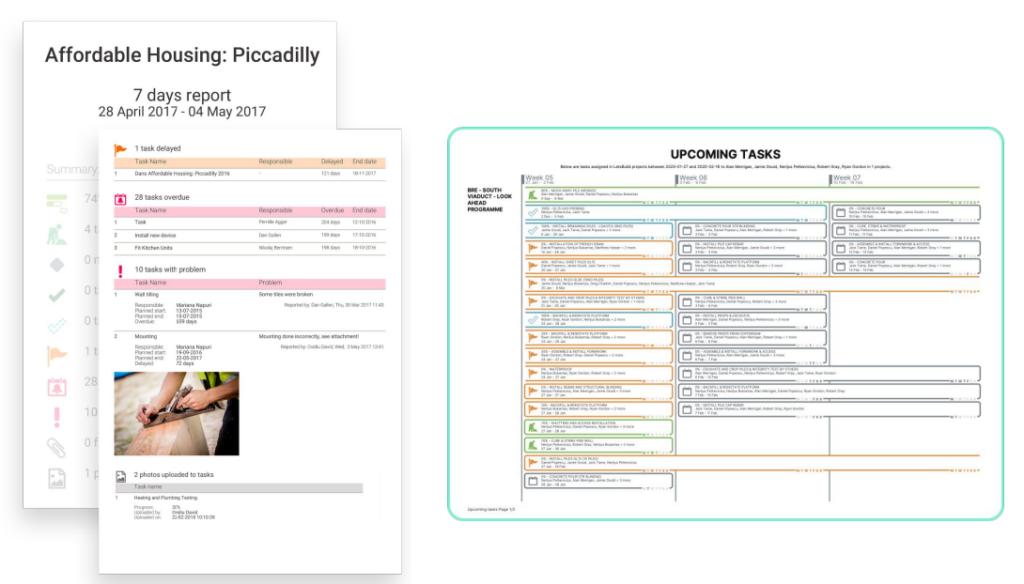
Users can filter essential information, create tailored templates, and produce error-free reports in just a few clicks. Plus, the analytics dashboard lets you analyze project progress through various lenses—by status, categories, responsible persons, or due dates.
One standout feature is the platform’s approach to data visualization. The color-coded status indicators and progress bars provide an at-a-glance understanding of project health. I think this visual approach will be useful for stakeholders who aren’t deeply involved in day-to-day project management.
That said, I couldn’t spot any advanced AI-driven capabilities, such as predictive analytics, automated insights, and intelligent trend analysis. For example, LetsBuild doesn’t use AI to forecast potential delays, analyze patterns in historical project data, or offer adaptive recommendations for resource optimization.
Verdict: 7/10
LetsBuild Customer Support
LetsBuild offers multiple support channels, including email, an online help center, and scheduled video consultations. The help center is well-structured, with detailed documentation, tutorial videos, and troubleshooting guides to help users navigate the platform. The support team is knowledgeable about construction project management, which I appreciated.
However, there’s no live chat option for immediate assistance. Email responses can sometimes take 24-48 hours.
That said, there’s a hotline number for emergency needs.
My personal experience with customer support wasn’t great. After filling out the demo form, I received an email response within around 4 hours with a presentation deck and a promise of a follow-up. It’s now been over a week, and I haven’t heard back.
Verdict: 6/10
What are LetsBuild’s Review Ratings from Review Sites?
(As of March 2025)
Capterra: 4.2/5
G2: 4.1/5
Software Advice: 4.2/5
TrustRadius: 10/10 (1 review only)
GetApp: 4.2/5
Google Play Store: No reviews yet
Apple App Store: No reviews yet
LetsBuild App Review
LetsBuild is a powerful platform that’s well-suited for mid to large-scale construction projects that require structured coordination and detailed oversight. Its strengths in snagging and defect management, drawing annotations, and project tracking make it a reliable choice for teams handling complex workflows and multiple stakeholders.
That said, LetsBuild has limitations. It lacks essential features like built-in scheduling, time tracking, location tracking, and in-app chat, which are often expected in modern construction management tools.
For smaller teams or those who rely heavily on mobile-first, all-in-one communication and scheduling, alternatives may be better.
Connecteam: The Better LetsBuild Alternative
The Connecteam construction app stands out as the best alternative to LetsBuild if you’re looking for a comprehensive construction project and worker management solution.
While both platforms offer digital forms and task management, Connecteam focuses more on workforce operations management, offering scheduling, time tracking, and online team chat—features absent from LetsBuild.
The Connecteam employee scheduler lets you assign and distribute work schedules digitally, with features like a drag-and-drop editor and scheduling templates for speeding up the process. There’s even 1-click scheduling—the system creates schedules for you, accounting for workers’ availability, qualifications, and more.
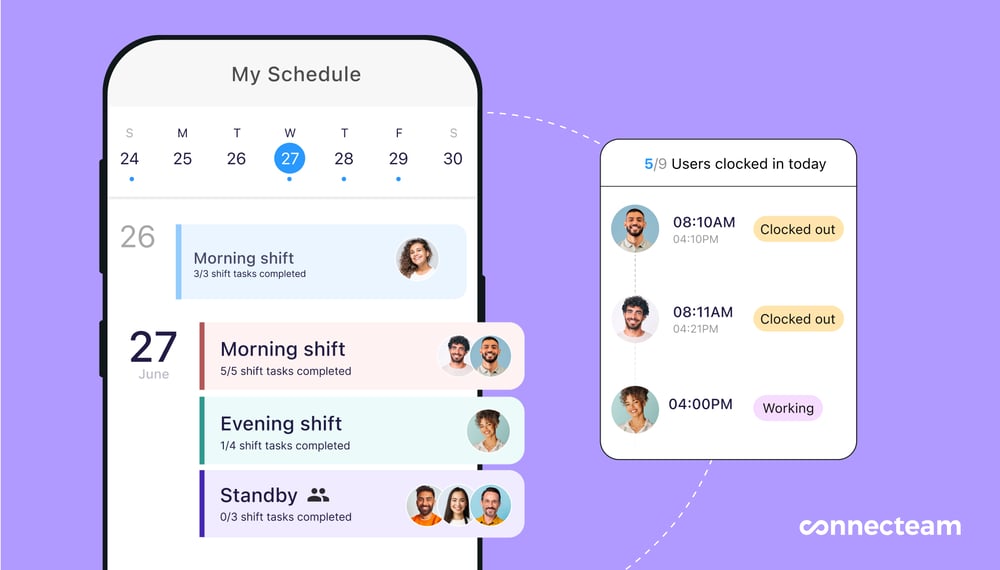
Plus, I love the employee time clock, which lets workers clock in and out from their mobile devices, shared kiosks, and more—tracking work hours, breaks, and overtime. You can track time against specific clients, projects, or jobs, too.
Connecteam also offers GPS-based features. The system can verify that workers are at designated locations when they clock in, and the geofencing functionality can send notifications when team members enter or leave specified work areas.
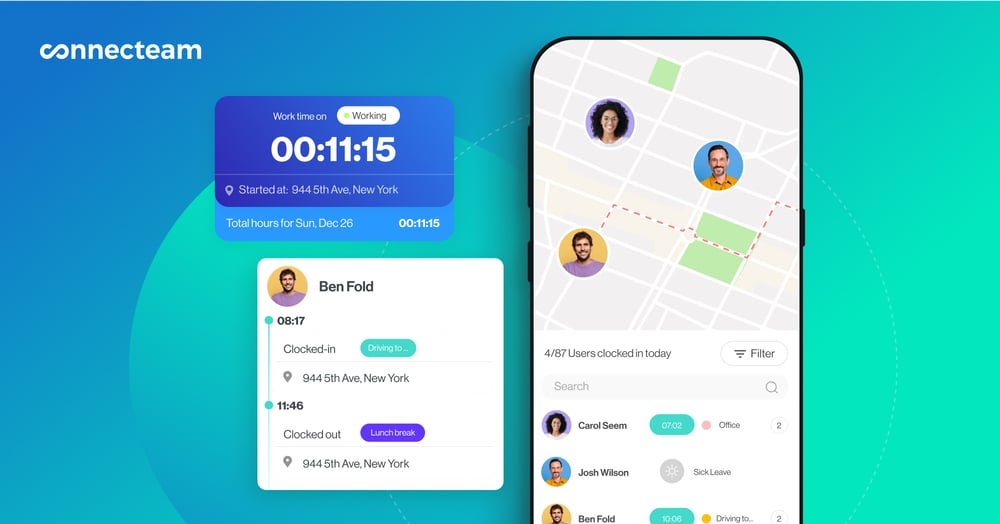
Moreover, Connecteam also includes built-in communication tools with its online team chat and company updates features.
For safety compliance, Connecteam provides a centralized company knowledge base where workers can access procedure documents, safety materials, and SOPs. Workers can also complete any required training right through the mobile app.
Finally, Connecteam offers a free-forever plan for teams of 10 or fewer…plus super affordable plans for larger teams.
FAQs
Interested users can request access to a free trial through LetsBuild’s website. That said, I requested a free trial and didn’t receive one.
- Check out our in-depth comparison of the best construction apps to find the one that’s right for you.
